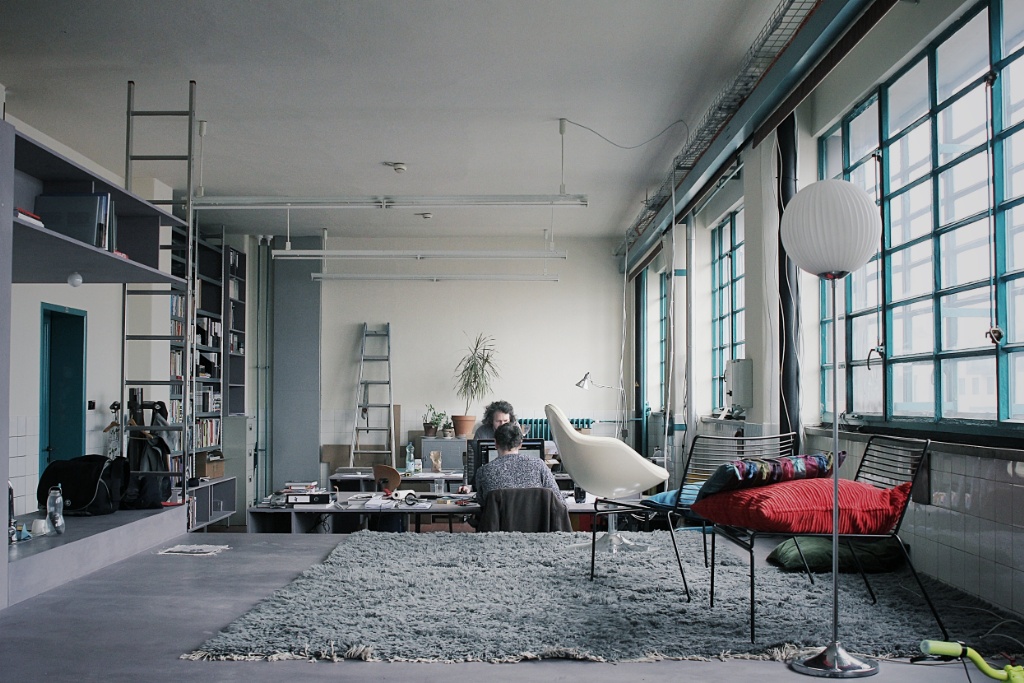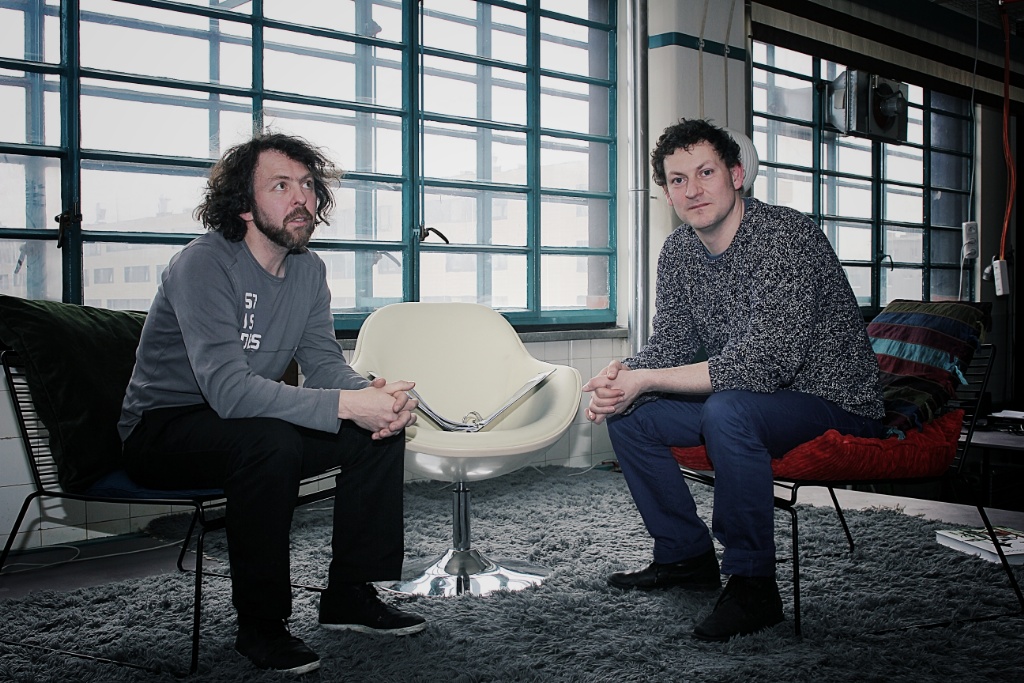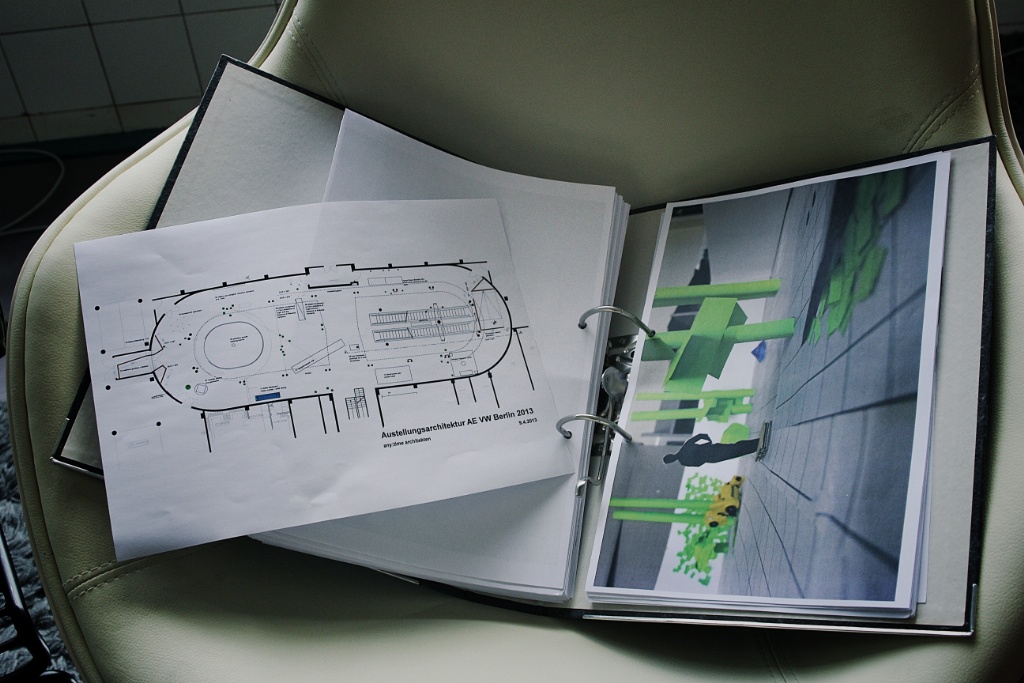“Like a Second Nature” is the latest exhibition Ars Electronica and VW have jointly staged in VW’s Automobilforum Unter den Linden in Berlin. The opening is set for June 6th. The exhibition design is by Jürgen Haller and Christoph Weidinger, two architects going by the name of any:time. We recently had a chance to chat with them in their new office suite in Tabakfabrik Linz.
any:time is located at the Tabakfabrik Linz

Jürgen: I suppose we should start at the beginning. We had the feeling that, in the exhibitions we’ve designed for the Volkswagen Forum Unter den Linden in recent years, we sorely neglected the rectilinear grid of the 1960s-style floor tiles that are a prominent feature of the venue. We initially chose the working title “Gänsehaut” (goose pimples), in the sense that you can’t really tell anymore whether what you see is real or artificial. Actually, that’s still the project’s name in our computer.
This time, the theme is nature, a second reality, which is the basis on which the selection of the works was made. What they have in common is that all contain elements of nature, formally, in some way or another.
Christoph: The focus is also very strongly on emotional affinities, on ways that individuals can discover their own approach to manifestations that mirror reality, on concepts to define the boundary between reality and an unreal realm. The nexus of the two is what this is all about.
Jürgen: It’s easier to explain this in terms of the individual pieces in the exhibition: Oribotics, Ene-Geometrix, Meter Crawler, Tele-Present Wind, Plant, Phantasm, Earth-Core-Laboratory and Elf-Scan, Wall, The Limitations of Logic and Absence of Absolute Certainty, Dynamic Structure and Specimen.
Here, we’re dealing with lots of things that can be grouped under the heading nature, science, art and technology, and we use the tile grid as a sort of detection system. In the exhibition space, we attempt to capture elements of nature. It comes across via this grid that looks like a piece a graph paper you used in school to classify phenomena via coordinates. This is our overarching external approach. And we also mirror this grid on the space’s walls, though always keeping our distance from the works of art. The result is a matrix, a possibility of ordering all the objects in the space by means of a mathematical process.
Nevertheless, during the process of creating the exhibition’s design, this pattern got to be too much, and the commissioning client came to feel that it dominated the whole space like in the film “Matrix”—a deluge of data, this aesthetic marvel. There, the concept was perceived with these expectations, but, from our point of view, that would have overpowered the works of art. It positively takes over the whole space, and there’s actually nothing left over.
Now, we fill this detection pattern with tiny, light, almost suggested green dots. We came up with spatial situations custom-tailored to the individual pieces—for instance, if Tarzan were striding through the jungle and saw the Meter Crawler, the snails, what would that situation look like? Snails prefer moist surroundings, so this looks like a tree that’s toppled over, though abstracted of course.
Christoph: We create territories, habitats for each individual object, but because there are so many objects, there’s also some overlapping.
Jürgen: We work with two elements. In the exhibition space, there are round supporting columns that were originally black but we’ve covered them in green. That means that we’re working with the dots floating over the detection grid and these vertical elements, the columns.
We’re building abstractions around the works of art.
WALL: a mirror, which actually doesn’t exist in nature, except for the surface of a river or other body of water. Here, the spatial abstraction is a large stream bounded by a landscape, a spatial, mirrored surface.
Ene-Geometrix: this has such an aura; here we use flickering lights, bioluminescent bacteria in swamps. Here, the stalks are extremely thin; they appear to be a sort of reed.
Tele-Present Wind: here, we thought of a steppe, though you don’t see much besides a smooth surface. The only element we have here, other than the work of art, is a point on the ceiling, a cloud point.
Brandis: here, we have a situation in which a medicine man meets Tarzan; Tarzan visits him in his cave, in his laboratory. The columns are pretty regularly spaced, not like out in the forest, so you’re entering the domain of the medicine man, as it were.
Each Transparent Specimen is placed on a small pedestal with the same diameter as the exhibit.
Christoph: These pedestals also hang from the ceiling, each at a different height.
Jürgen: This situation is also a bit like the reeds. Tarzan watches a butterfly alight on a large stalk.
Dynamic Structures is set in a time-lapse situation. The work of art casts sharply defined shadows, and the movement of the sun makes the shadows move across the wall. Tarzan is sitting in a tree, ruminating. What we stage in this space is a shadow narrative the installation visitor is pleased to partake of.
The artificial Tornado cut a swath through the exhibition. There are broken stalks; the dots have been tempest-tossed about the space. There are strong horizontal elements here that reflect the storm’s dynamism.
Plant: Here, we asked ourselves: When do plants make noise? Never, actually, unless there’s something dripping. That’s why we’ve created a grotto-like situation here in which we make very intensive use of the green dots.
The thing with the butterflies is very romantic. Here, the picture we had in mind is of Tarzan extracting a thorn from Jane’s foot and she’s all better. The butterflies alight out of a sort of need. The work of art itself engenders a very intimate situation.
Christoph: We’ve just spoken about the situations in such a matter-of-fact way, but coming up with them was very process-oriented. The encounters with the objects, with Martin Honzik (festival director and head of Ars Electronica Export), with the people working in a curatorial capacity on Volkswagen’s staff were highly discursive. The ideas underwent metamorphosis over the course of the process; the selection of objects was modified; the narrative corresponding to each one changed as did the look of the accompanying mise-en-scène.
Christoph Weidinger and Jürgen Haller

There are areas that call for brightly lit situations and those that demand a darker look. How to deal with these facts and circumstances as well as with the objects themselves are matters that we considered relatively early in the conceptualization process. We as planners were already integrated into this project during the curatorial phase. We were brought in to contribute to conceiving and developing this project, to envisioning how the entire ensemble could work in this space, to get a feeling for the situation, just as Jürgen described it as Gänsehaut.
After all, this deals with an emotional subject, with self-exploration, and stuffing a lot of things into a spatial corset isn’t conducive to this. All who enter this space must immerse themselves in this effort to attain self-awareness and become curious about what these dots are all about.
We were involved in the planning from the very outset in order to develop mental images. This time around, it entailed coming up with a way to deal with artificiality—what are the limits, what’s natural and what’s artificial, and to what extent can the eye be deceived?
Jürgen: The exhibition architecture we developed last year strongly accentuated the spatial dimension. This year, there are several works on display that themselves take up so much room and have such a powerful presence—Blinking Leaves, for example. The last thing we wanted to do here is to invade their space; these objects require nothing supplementary. This makes an impact on the concept—if other objects were present, the exhibition’s narrative would take on a totally different appearance.
How would you characterize the relationship between your work and the commissioning client’s ideas?
Christoph: Needless to say, this can’t be expressed in terms of percentages. We are process- and discourse-oriented. We enjoy developing things in a group setting and discussing a great deal. But we also very much appreciate it when each member of the group can bring his or her particular expertise to bear, when a sense of trust prevails—as in our case, how to best come to terms with space and material. This is important, especially in the collaboration process with Ars Electronica, which is actively involved in many different areas and where there’s trust in our judgment as to how to deal optimally with space. We’re given wide-ranging creative freedom, though, of course, always within the framework of strict budgetary constraints. We have to use relatively limited ways and means to maximize the impact of the mise-en-scène and create the best possible visitor experience, but this must be in proportion to the works. Sometimes, restraint is called for. Of primary importance are the works themselves, the artistic positions, the contents they seek to convey.
Ideas, sketches, concepts and more

So, we always try to avoid developing a Big Idea at the outset and doggedly pursuing it. Lots of ideas emerge from the discussions, the mood fluctuates frequently, and this often persists until the very end when the exhibition finally has to assume a physical form. The upshot is a coherent ensemble performance that gets the most out of all those involved, one that achieves the best possible result for the works, for the artists, for the space and the way we designers deal with it.
One can wish for just about anything, dreams are potentially infinite, but in the end this is all about actually implementing a feasible solution. One is faced with multifarious tasks and challenges, and all these complex considerations must finally be reduced to a simple point—creating an exhilarating space for the people who come to partake of the exhibition.
“Like a Second Nature” is the fourth exhibition that Ars Electronica has conceived and executed at Volkswagen Automobil Forum Unter den Linden in Berlin. It opens on June 6th. Detailed, comprehensive info is online at https://ars.electronica.art/wieeinezweitenatur. Over the coming weeks, the blog will feature interviews with the artists and curators.